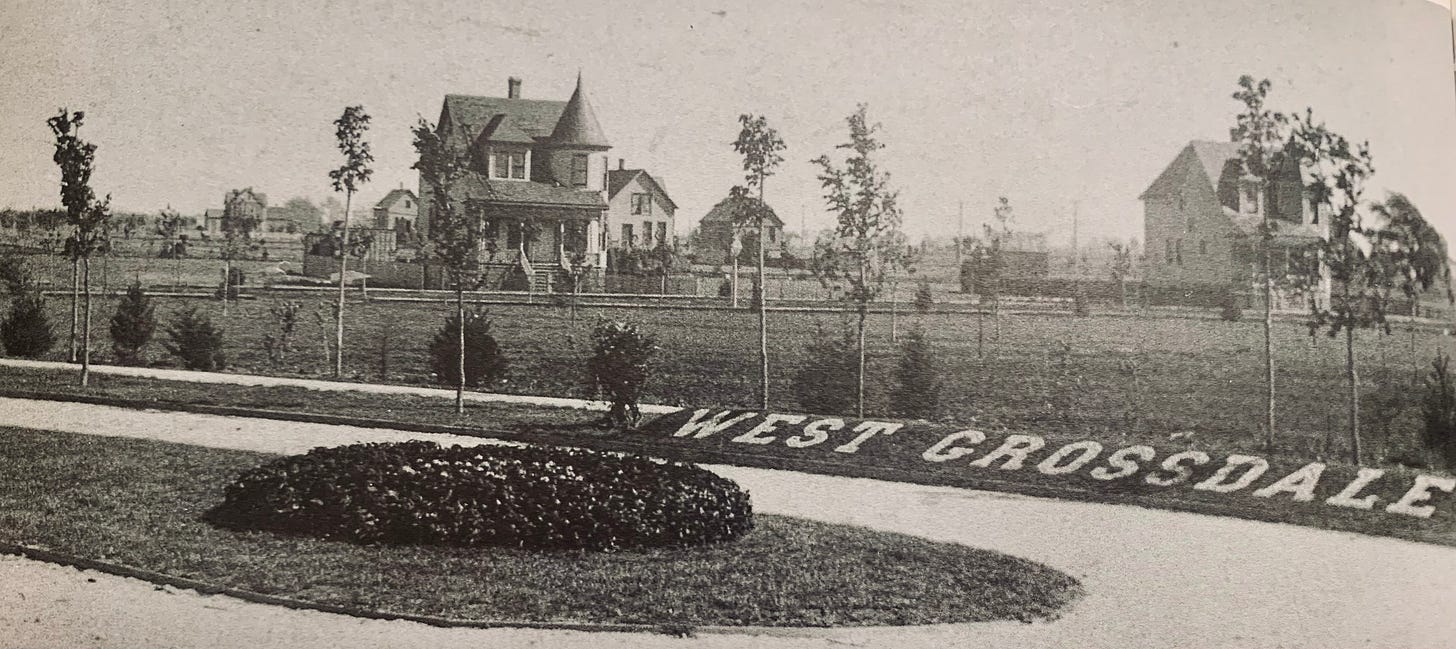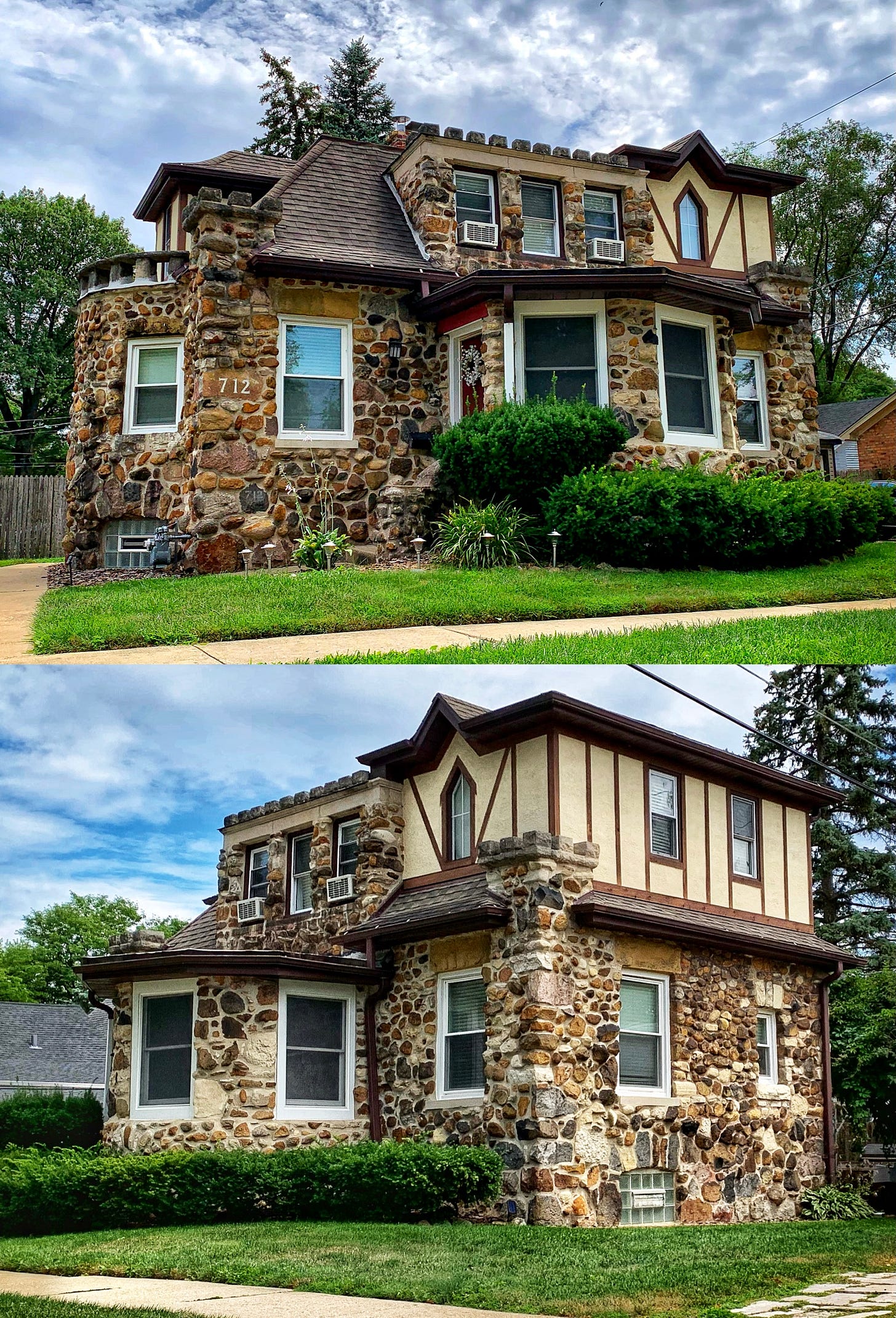The Boulder Homes of Brookfield
Conrad Schneider lived and worked in the Congress Park section of Brookfield between 1897-1922. During that time he designed and constructed dozens of buildings, known as “boulder homes,” not just in Brookfield but also in nearby La Grange, La Grange Park, and Riverside. The name came about from Schneider’s practice of collecting field stones found in the local prairies and incorporating them into his “last ever” structures. A 1905 newspaper noted that “boulder homes (were) a specialty” of the builder.
This area was once described as the “Grand Prairie” full of sand and open prairies that “embraced the Old Portage route…and the Des Plaines (river).” Although Schneider used common building materials of the day, the fact that he took advantage of the local stone, however impractical, is what makes his houses so memorable and unique. They’re delightful curiosities; almost fairytale-like in design with their turrets and battlements.

Although not a licensed architect, Conrad Schneider was a contractor and builder, a stone mason, and did boulder and cement work of all kinds. Originally from Galena, the 34-year-old Schneider was the son of German immigrants and had traveled extensively outside of Illinois, including South Dakota, before settling in the Brookfield area in 1895. Who knows where Conrad gained his particular skills but he used them to produce all kinds of structures in his new hometown: residences from Queen Annes to bungalows, commerical buildings, schools, and even a fountain. He was part of a husband-and-wife team as Conrad created the outside of his buildings, while his wife Anna Iverson designed the interiors.


Formerly known as Grossdale, Brookfield was the creation of developer Samuel Eberly Gross, who ultimately constructed around 10,000 homes across Chicagoland in his lifetime, including Alta Vista Terrace and a subdivision along 5th Ave in East Garfield Park. He was responsible for turning a former oatfield near Salt Creek into a prosperous suburban community. Beginning in 1889, he acquired lots on both sides of the CBQ railroad and over the next six years platted three subdivisions - Hollywood, Brookfield, and Congress Park - that were all later incorporated into one village. Schneider was hired to design and build West Grossdale’s first structures (it was renamed Congress Park after early residents became “disgruntled” with the developer and there were a number of lawsuits, allegations, and injunctions made against him).


Conrad Schneider built the first residence in Gross’ new Congress Park (then known as West Grossdale) in 1897. Located at 4172 DuBois Boulevard, the first family to occupy this “boulder home” were Samuel’s brother Jonathan Wesley Gross along with his wife Sophia, son Jon, and daughter Ella. Two years earlier, Schneider erected Congress Park’s first commercial structure, the West Grossdale Opera House, at the corner of Ogden Avenue and DuBois Boulevard with stores on the ground level and a large Victorian theater above. A nephew of Samuel Gross, Homer, ran the post office from it, which later acted as a community club house. Completely boulder-sided, the structure burnt down in 1981 but some of the exterior stones survive at the Brookfield Historical Society, located in the historic Grossdale train station. In September of 1900, Schneider built the area’s first school, originally called East School, at the corner of Shields and Raymond Avenues. Unfortunately the last of this structure’s exterior boulders were covered up twenty years ago.
The largest concentration of “boulder houses” can be found on Raymond and Deyo Avenues, which have a grand total of eighteen. Schneider built his own home (made of boulders of course!), a mini-castle at 4126 Raymond Avenue, where he lived with his wife Anna and daughter Mabel. The base of his operations supposedly took place in the boulder-sided coach house out back. He was a busy man as Samuel Gross most likely commissioned him to put up many of the homes, altogether nearly 30, in the new Congress Park subdivision. An 1898 guide showcased Schneider’s boulder-covered homes, which might have been a selling point. Unfortunately many of them have been altered over the years, including Schneider’s personal residence. But what’s interesting is you can’t miss the stones, peaking out from the sides or foundations of the covered-up structures, or even Schneider’s trademark battlements that survive at 4147 Deyo Ave. One can only imagine what these homes originally looked like before they were severely modified.

One of the more interesting buildings to receive “the Conrad treatment” was a Sears kit home located at 4009 DuBois Boulevard. Around 1915 a Sears model known as “The Sherburne” was customized with Schneider’s boulder decor. Instead of a cement block base, Schneider used boulders for the foundation and also incorporated them into the porch and chimney. He also changed other details, like relocating the front porch stairs to the alley side and building a wide second floor viewing porch. Sears homes were famously delivered by rail, so it’s interesting to point out this structure is not even a block away from the tracks (and located less than 10 miles from the original Sears Roebuck headquarters in Chicago’s Lawndale). The Sears home sold just four months ago.
For less than $200, Schneider also designed and built a bubbling fountain and horse trough in Brookfield in 1906 that consisted of colorful field stones in “an ingenious arrangement” and even included a cobblestone step for children. Decorated with flowers and cut stone at the top, it was piped for both gas and electricity. In an October 1916 issue of Building Age, the “novel” and “pleasing” design was “something…the contractor can point to with pardonable pride.” Installed right outside the Brookfield Village Hall, it was in use through the late 1950s.

Next door in La Grange you’ll find a home appropriately called “The Boulders,” which was built for Mr. E.D. Floyd around 1906. In September of 1916 the LaGrange Citizen wrote about some of Schneider’s residential projects, with the builder mentioning he had purchased property on Ashland Avenue in La Grange Park where he hoped to “improve it with one of [his] unique and original buildings.” Schneider did create such a house, specifically at 535 N. Ashland Ave. Two of his homes, including the one in La Grange Park, were featured in the May 1917 issue of Motor Age, which noted that Schneider constructed fireproof concrete roofs along with built-in garages. Another one of his “boulder homes” existed at 37 Longcommon Road in historic Riverside, exhibiting many of Schneider’s trademarks, but it was torn down in 2005.

Sadly by 1918 all that heavy exertion of lifting countless rocks and stones finally caught up with the builder, and Conrad Schneider became a semi-invalid. Some of his last projects were simple remodelings like stone-covered porches. He died from a stroke at the age of 60 in September of 1922. Although today he is virtually forgotten, except for the people of Brookfield’s Congress Park and neighboring suburbs where you can find his work, Schneider’s nearly thirty buildings live on in some form or another. His unique designs, especially the castle-like homes with crenellated walls, make them stand out in our current architectural landscape where everything looks exactly the same.
Sources:
Brookfield, Illinois: A History
Book of the Western Suburbs: Highways and Byways, Past and Present
https://www.rblandmark.com/2005/09/06/bigger-and-boulder/
Brookfield Historical Society and Library








